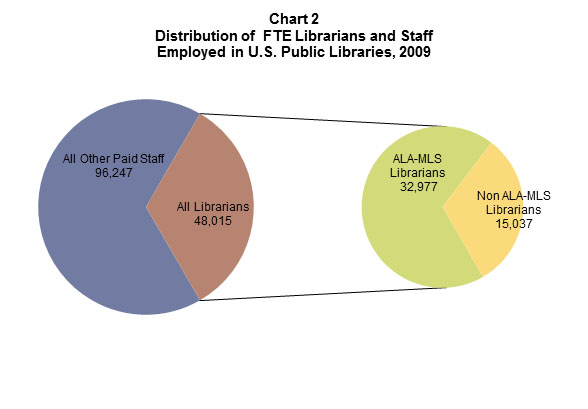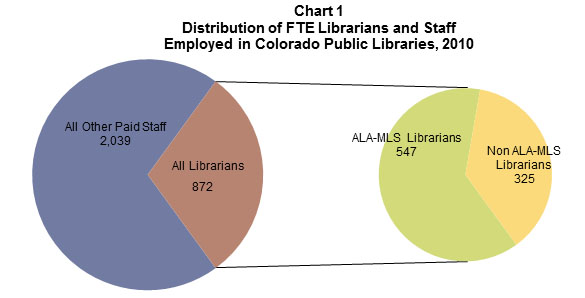Among numerous other statistics, both the Colorado Public Library Annual Report (PLAR) and the Public Libraries Survey (PLS), a national report published by the Institute of Museum and Library Services (IMLS), gather and publish information about the number of staff, librarians, and ALA-MLS librarians working in public libraries in the state and the nation.
Personnel Categories
Librarians: Persons with the title of librarian who do paid work that usually requires professional training and skill in the theoretical or scientific aspects of library work, or both, as distinct from its mechanical or clerical aspect.
ALA-MLS Librarian: Librarians with master’s degrees from programs of library and information studies accredited by the American Library Association.
All Other Paid Staff: This includes all other FTE employees paid from the reporting unit budget.
Colorado Library Staffing
According to the 2010 PLAR,[note]At the time of publication, this was the most recent year of data available.[/note] approximately 59 percent of Colorado’s public library jurisdictions employ at least 1 person with an ALA-MLS degree.[note]At least 1 library is known to employ ALA-MLS librarians, but does not report this figure.[/note] Of the 67 libraries that reported employing an ALA-MLS librarian, 4 reported having less than 1 full-time ALA-MLS position.
As measured in full-time equivalents (FTEs), more than 6 out of 10 librarian positions in Colorado’s public libraries are staffed by ALA-MLS librarians (63%), and nearly 1 in 5 of all staff positions (19%) (see Chart 1).[note]Staffing data is reported in full-time equivalents (FTE).[/note] Looking back over time, these figures have remained relatively stable; on average, since 2005, ALA-MLS-certified librarians represented 63 percent of FTE librarians working in public libraries, and just under 19 percent of the public library workforce in general. Thus, it seems that external forces, such as the recession, have had little bearing on the proportion of ALA-MLS librarians versus non ALA-MLS librarians working in Colorado’s public libraries. However, the data does not shed light on the issue of part-time versus full-time positions and their relative rise or fall.
National Library Staffing
The 2009 PLS data published by IMLS reported that 4,464 of 9,225 U.S. public libraries had ALA-MLS librarians.[note]Institute of Museum and Library Services, 2009. Public libraries survey, fiscal year 2009. Retrieved from https://harvester.census.gov/imls/pubs/pls/pub_detail.asp?id=140#. At the time of publication, this was the most recent year of data available.[/note] Thus, less than half of all public libraries in the United States employ at least 1 ALA-MLS librarian (48%). Colorado bests this average, but ranks only 24th nationally, falling behind other states in which greater percentages of public libraries employ ALA-MLS librarians.
Also according to the PLS data, U.S. public libraries employed more than 144,261 FTE staff, 48,015 of whom were classified as librarians (33%) and 96,247 as other paid staff (67%) (see Chart 2).[note]Staffing data is reported in full-time equivalents (FTE) and rounded to the nearest whole number.[/note] Nearly 7 out of 10 librarians had an ALA-MLS degree (69%) and approximately 1 in 5 of all staff had these credentials (23%).
 In terms of the percentage of public libraries employing ALA-MLS librarians, and also the ratio of ALA-MLS librarians to other staff, Colorado is more-or-less on par with national trends. Of course, whether a library can hire ALA-MLS librarians is largely a matter of economics, location, the availability of accredited applicants, and other factors. Yet, the distribution of librarians with and without ALA-MLS degrees is an issue critical to libraries and the profession of librarianship.
In terms of the percentage of public libraries employing ALA-MLS librarians, and also the ratio of ALA-MLS librarians to other staff, Colorado is more-or-less on par with national trends. Of course, whether a library can hire ALA-MLS librarians is largely a matter of economics, location, the availability of accredited applicants, and other factors. Yet, the distribution of librarians with and without ALA-MLS degrees is an issue critical to libraries and the profession of librarianship.
The Public Library Annual Report (PLAR) is a survey of all public libraries in Colorado. Visit LRS.org to obtain PLAR data and to read more Fast Facts about workforce trends in Colorado libraries.
Public Libraries Survey (PLS) data can be found on the IMLS website at: http://www.imls.gov/research/default.aspx.
